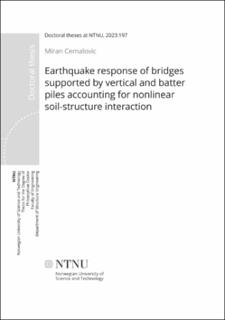| dc.description.abstract | Around the world, large structures such as bridges, harbours and skyscrapers, are built in areas where the seismic risk is relatively high. In many cases, these structures are supported by deep foundations due to overlaying soft soil. During an earthquake, the response of the structure and the response of the soil depend on each other. The ground motion influences the displacements of the structure and the motion of the structure influences the displacements of the soil. This is referred to as soil-structure interaction (SSI) and the phenomena may be particularly important for structures supported by deep foundations. Easy access to commercial FE-software allows for accurate assessment of most structural and geotechnical problems. However, obtaining rigorous numerical solutions for dynamic soil-structure interaction response is a challenging and time-consuming process that often requires a cross-disciplinary skill set. As a result, simplified methods that are robust, user-friendly, and verifiable are often preferred in practical engineering.
The main objective of this doctoral work is to aid the industry with practical computational methods for analyzing structures, particularly bridges, that are supported by deep foundations using both vertical and batter piles. These methods aim to capture the essence of SSI while also being straight-forward to understand, implement and apply.
The thesis is divided into four parts. The first part investigates the kinematic response of vertical and batter pile groups by evaluating how non-linearity, batter angle, pile spacing and excitation frequency affect pile-cap displacements, rotations, maximum pile moments, shear forces and axial forces. The second part introduces a diagonal impedance matrix for vertical and batter pile groups in linear, homogeneous soil that takes into account pile-soil-pile interaction. The solution is suited for low-exaction seismic problems, vibration problems or estimates in the early-stage design process. The third part presents a nonlinear macro-element for vertical and batter pile groups. The solution is intended for realistic nonlinear time-history analyses and efficient estimation of equivalent linear properties. The fourth part introduces a finite element framework for seismic analysis of structures that incorporates the previously developed solutions.” | en_US |
